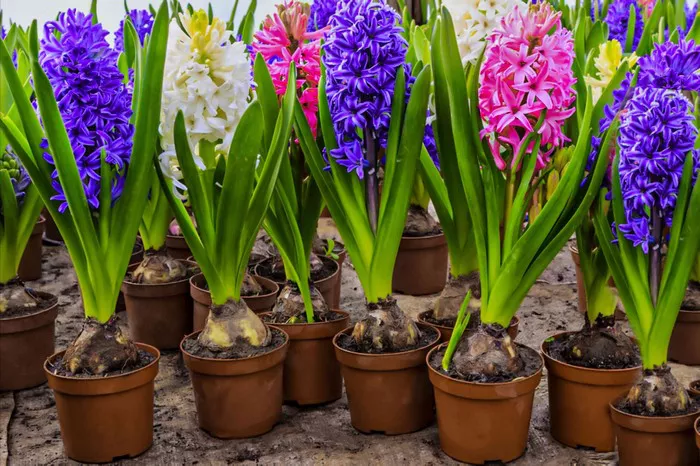In the realm of gardening, few sights evoke as much delight and admiration as a cluster of vibrant, fragrant hyacinth blooms. With their rich colors and intoxicating scent, these perennial favorites are a staple in many gardens and floral arrangements. But just how many flowers can one expect from a single hyacinth bulb? This question, often pondered by enthusiasts and novices alike, warrants a closer examination. In this article, we delve into the fascinating world of hyacinths, exploring their growth patterns, cultivation techniques, and the factors that influence their blooming potential.
Understanding Hyacinth Growth
Before delving into the specifics of flower production, it’s essential to understand the growth cycle of hyacinth bulbs. Hyacinths belong to the genus Hyacinthus and are native to the eastern Mediterranean region. These bulbs are typically planted in the fall, allowing them to establish roots before the onset of winter. During the colder months, the bulbs remain dormant, conserving energy and preparing for the spring emergence.
As temperatures begin to rise in early spring, hyacinth bulbs awaken from their dormancy, sending shoots upward in search of sunlight. These shoots eventually develop into sturdy stems, adorned with tightly packed floral buds. Under optimal conditions, hyacinths can produce an impressive display of flowers, creating a striking focal point in any garden.
Factors Influencing Flower Production
The number of flowers that emerge from a single hyacinth bulb can vary depending on several factors. Understanding these factors is crucial for maximizing bloom potential and ensuring a bountiful display.
Bulb Size: The size of the hyacinth bulb plays a significant role in flower production. Larger bulbs typically contain more stored energy reserves, allowing them to support the development of multiple flower stems. Bulbs that are too small may produce fewer flowers or fail to bloom altogether.
Varietal Differences: Hyacinths come in a wide range of cultivars, each with its unique characteristics and flowering habits. Some varieties are known for their prolific blooming, producing numerous flowers per bulb, while others may be more modest in their display. When selecting hyacinth bulbs, it’s essential to consider the specific cultivar and its potential for flower production.
Growing Conditions: The growing conditions in which hyacinths are cultivated can significantly impact their blooming potential. Adequate sunlight, well-drained soil, and proper moisture levels are essential for healthy growth and abundant flowering. Additionally, providing sufficient nutrients through fertilization can support robust flower production.
Cultural Practices: Proper planting and maintenance techniques are vital for encouraging optimal flower production in hyacinths. Planting bulbs at the correct depth, spacing them adequately, and removing spent blooms can promote continuous flowering throughout the season. Additionally, protecting bulbs from pests and diseases can prevent damage that may hinder flower development.
Maximizing Flower Production
While the exact number of flowers produced by a single hyacinth bulb can vary, there are several strategies gardeners can employ to maximize bloom potential:
Select High-Quality Bulbs: Choose bulbs that are firm, plump, and free from signs of disease or damage. Larger bulbs are generally preferable, as they tend to produce more flowers.
Plant in Rich, Well-Drained Soil: Hyacinths thrive in fertile, well-drained soil with a neutral pH. Incorporating organic matter such as compost can improve soil structure and provide essential nutrients for healthy growth.
Provide Adequate Sunlight: Hyacinths require full sun to partial shade to thrive. Plant bulbs in a location where they will receive at least six hours of sunlight per day for optimal flowering.
Water Wisely: Keep the soil evenly moist but not waterlogged during the growing season. Avoid overhead watering, as this can lead to fungal diseases. Water deeply once a week, allowing the soil to dry out slightly between waterings.
Fertilize Regularly: Feed hyacinths with a balanced fertilizer formulated for flowering bulbs. Apply fertilizer in early spring before the bulbs begin actively growing, and again after flowering to replenish nutrients for the next season.
Mulch to Conserve Moisture: Apply a layer of organic mulch, such as shredded bark or straw, around hyacinth bulbs to help retain soil moisture and suppress weeds. Mulching also insulates the soil, protecting bulbs from temperature fluctuations.
Deadhead Spent Blooms: Remove faded flowers promptly to encourage the production of new blooms and prevent the plant from expending energy on seed production.
By implementing these practices, gardeners can enhance the flowering performance of hyacinths and enjoy a spectacular floral display year after year.
Conclusion
The allure of hyacinths lies not only in their exquisite beauty but also in their remarkable ability to produce an abundance of flowers from a single bulb. While the exact number of blooms may vary depending on various factors, from bulb size to growing conditions, with proper care and attention, gardeners can coax these bulbs to reach their full flowering potential.
Whether planted in garden beds, containers, or indoor displays, hyacinths never fail to captivate with their vibrant colors and intoxicating fragrance. By understanding the factors that influence flower production and employing sound cultivation practices, gardeners can unlock the full blooming potential of these beloved springtime treasures.


